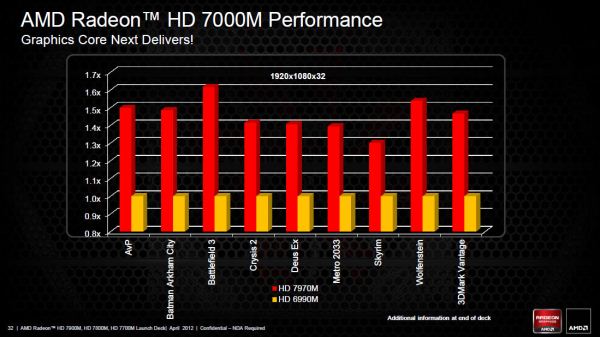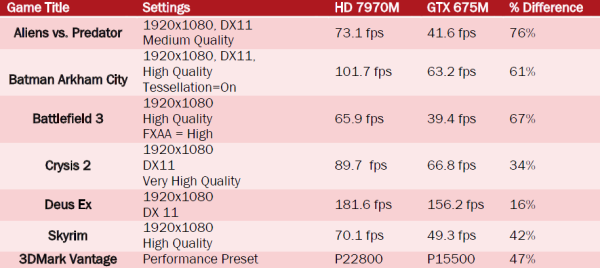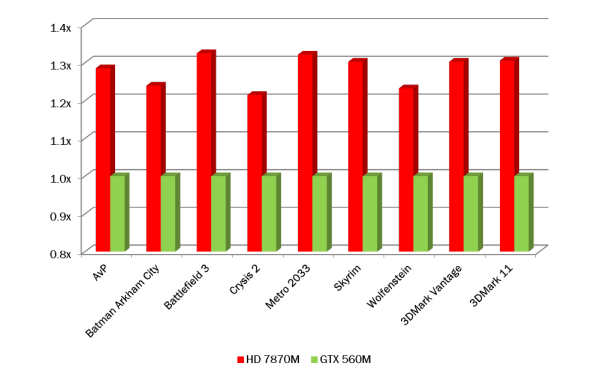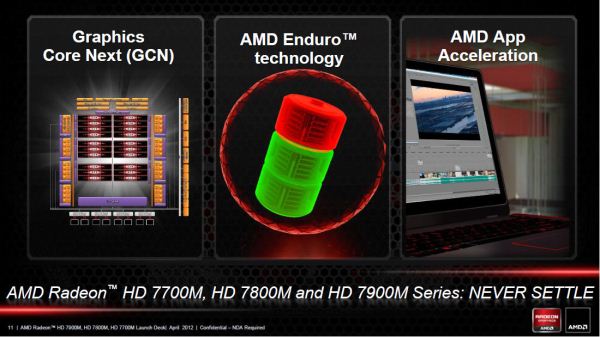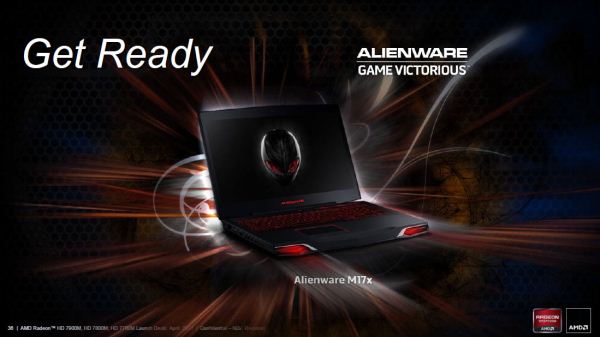
Original Link: https://www.anandtech.com/show/5778/amd-launches-radeon-7700m-7800m-and-7900m-mobile-gpus
AMD Launches Radeon 7700M, 7800M, and 7900M Mobile GPUs
by Jarred Walton on April 24, 2012 4:25 AM EST- Posted in
- AMD
- GCN
- Laptops
- Radeon HD 7000
- GPUs
AMD Launches Radeon Mobility 7700M, 7800M, and 7900M GPUs
Late last year, AMD pushed out the first of their Southern Islands GPUs for the desktop, the HD 7970. Around the same time, AMD also announced their first 7000M mobile GPUs. Since then, AMD has gone on to launch the HD 7950, the HD 7750/7770, and the HD 7850/7870. Meanwhile, on the mobile front we’ve had to sit back and wait…and wait. Today, the waiting ends, at least for one of the parts: the HD 7970M is now shipping in select notebooks, and the other GPUs will likely start showing up in other laptops and notebooks over the coming weeks.
As is customary for AMD and NVIDIA, new GPUs debut on the desktop, and after a while they trickle down into the mobile world. NVIDIA actually pulled a fast one with GK107 actually coming out ahead of the desktop GK104, which may be a sign of the changing times, but AMD’s GCN is sticking with the traditional route of using lower clocked power optimized versions of already launched desktop chips for their mobile parts. Not that there’s anything wrong with that from a business standpoint, but it does make laptop users feel like second class citizens. Before we continue the discussion, let’s list the specs.
| AMD Radeon HD 7900M, 7800M, and 7700M | |||
| Radeon HD 7900M | Radeon HD 7800M | Radeon HD 7700M | |
| Core Name | Wimbledon | Heathrow | Chelsea |
| Stream Processors | 1280 | 640 | 512 |
| Texture Units | 80 | 40 | 32 |
| ROPs | 32 | 16 | 16 |
| Z/Stencil | 128 | 64 | 64 |
| L2 Cache | 512KB | 512KB | 512KB |
| Core Clock | 850MHz | 800MHz | 675MHz |
| Memory Clock | 4.8GHz | 4.0GHz | 4.0GHz |
| Memory Type | 2GB GDDR5 | 2GB GDDR5 | 2GB GDDR5 |
| Memory Bus Width | 256-bit | 128-bit | 128-bit |
| Memory Bandwidth | 153.6GB/s | 64GB/s | 64GB/s |
| PCI Express | 3.0 | 3.0 | 2.1 |
Starting at the high end, AMD will have the 7900M series. Note that there will be more than one part for each family, but AMD is currently providing the configuration for the highest performance parts in each category. At the top, the HD 7970M uses a fully enabled Pitcairn core. The GPU clock is 850MHz compared to 1000MHz (stock) on the desktop HD 7870, but surprisingly AMD is going whole hog on the RAM and featuring 2GB of 4.8GHz GDDR5. That makes the 96GB/s bandwidth of NVIDIA’s GTX 580M/675M positively pale in comparison, and we’d wager the GPU performance will easily reclaim the mobile performance crown—at least until NVIDIA launches the inevitable GTX 680M, but we don’t know when that will be. Going by the core clocks, the HD 7970M should be about 15% slower than the HD 7870, and given the fact that no consumer laptops have yet shipped with an LCD resolution above 1920x1200, you can look at our HD 7870 benchmarks and subtract 15% to get a pretty good idea of how the HD 7970M will perform.
AMD was also "kind" enough to provide a comparison slide with their own benchmarks, showing performance relative to the HD 6990M. As always, take these graphs for what they're worth:
HD 6990M was certainly no slouch as far as mobile gaming is concerned; you can see how it stacked up against the GTX 580M in our Alienware M18x head-to-head in both single- and dual-GPU configurations. The quick summary is that across the eight games we tested last year, SLI GTX 580M averaged out to approximately 8% faster than CrossFire HD 6990M; for single GPUs, the result is more in NVIDIA’s favor: the GTX 580M was 8% faster at our Ultra settings, and 17% faster at our High settings. Assuming AMD’s numbers are correct (and given the amount of memory bandwidth and GPU cores we’re looking at, we see no reason why they wouldn’t be), it looks like HD 7970M will be around 45% faster than the HD 6990M on average, or about 25% faster than a single GTX 580M.
AMD also presented some data showing their estimate of performance results for HD 7970M vs. GTX 675M, which you can see below, though it appears that information was simulated using desktop hardware (Core i7-2600K) and while the numbers are likely accurate, the selection of games and the chosen settings could be debated. AMD obviously isn't an unbiased review source. Now we can wait for NVIDIA’s inevitable response with a high-end mobile Kepler.
The other two GPUs are an interesting pair. Both use the Cape Verde core, but where the 7800M is a fully enabled 640 core part, the 7700M disables a couple compute clusters and ends up with 512 cores and 32 texture units. AMD also clocks the 7700M lower, most likely to hit lower TDP targets for laptops rather than because of inherent limitations with the chips. Compared to the desktop parts, the (presumed) HD 7870M will run the core at 800MHz vs. 1000MHz on the HD 7770 GHz Edition, and memory is at 4GHz effective compared to 4.5GHz on the desktop parts. For the (again presumed) HD 7770M, the core will run at 675MHz compared to 800MHz on the desktop HD 7750.
There’s one other big difference between the HD 7700M and the HD 7800M: PCI Express 3.0 support will not be present on the 7700M. Before anyone gets too upset, we need to put things in perspective. First, while PCIe 3.0 has improved performance with HD 7970 on the desktop, for the HD 7700M we’re looking at a part that has only one fourth the compute power. Second, remember what we just said about HD 7700M being clocked lower most likely in order to hit TDP targets? We asked AMD about the removal of PCIe 3.0 support (given both families use Cape Verde, the potential is certainly there), and their response confirmed our suspicions: “The Cape Verde die itself supports PCIe 3; the reason we chose not to include it in our 7700M is because it mostly targets platforms where power saving is king, and the sacrifice (though not huge) in that regard would not have been justified by the small performance gain going from gen 2 to gen 3.”
And for the curious, once again AMD provided an estimate of performance for the 7870M vs. the GTX 560M (simulated using desktop hardware). Results are at 1920x1080/1920x1200 with a variety of quality settings, so take the following with a grain of salt.
GCN HD 7000M: Key Features and Technologies
With the chips themselves out of the way, let’s discuss some of the other features. The three key items AMD mentions in the above slide are GCN, AMD Enduro Technology, and AMD App Acceleration. The first we’ve already covered, and there’s not much new to say with regards to AMD’s App Acceleration—there are apparently 200+ GPU-accelerated applications. The second item sounds far more interesting for the mobile world, though, so let’s dig a little deeper into Enduro and AMD’s power technologies in general. The following gallery contains all the pertinent slides for this discussion.
Like the desktop Southern Islands parts, all of the higher-end mobile variants will have power gating and ZeroCore technology. That means that idle power draw should be a step down from where we’ve seen it on previous mobile GPUs, and for CrossFire configurations it means that the secondary GPU can be completely shut down when it’s not in use. As for Enduro, AMD informed us that this is the latest iteration of their dynamic switchable graphics technology. We asked for additional details, but AMD didn’t really have anything more to add to the discussion so it could be that Enduro functions exactly like dynamic switchable graphics on the previous generation 6000M parts. And despite the above slide showing an AMD APU and GPU, Enduro will also work with Intel CPUs like Sandy Bridge and Ivy Bridge.
There are two problems that AMD didn’t really have an answer for in our conversation: first, the user interface for dynamic switchable graphics was pretty weak the last time we looked at it. We’re not sure if it’s any better six months later, but let’s hope so. The second is the real concern: until we can get AMD driver updates separate from Intel driver updates, it’s our opinion that Enduro won’t be particularly useful on Intel gaming platforms. With HD 7970M being such a potent chip, it would certainly be CPU-limited on AMD’s Llano APU, and unless Trinity really manages to improve on Bulldozer performance, it will likely also pose a CPU bottleneck for HD 7970M (never mind CrossFire configurations). So, once again we informed AMD that we really need an answer to the driver updates dilemma for switchable graphics laptops, and they need to get laptop OEMs (e.g. Sony and HP) to allow users to download AMD reference drivers.
Of course, if ZeroCore technology and power gating works well enough, all this discussion of switchable graphics may be moot: imagine a laptop with a discrete GPU that idles at the same power requirements as an IGP; why would you even want switchable graphics if you don’t need it to save power? We’ll have to wait for hardware to see how 7700M and above fare in terms of idle and low load power draw, but we could end up pleasantly surprised. I’ve stated in the past that the holy grail for laptop GPUs at this point is to use as little power as IGPs when there’s nothing complex happening, and ZeroCore and power gating could actually deliver on that goal.
One final feature that was mostly glossed over in the slides is VCE support—AMD’s Video Codec Engine that we have yet to see demonstrated. It’s still present on these mobile parts, and on paper VCE is a competitor to Intel’s Quick Sync technology. Originally discussed back in December when AMD launched HD 7970, we thought we’d see some software make use of the feature by this point. I even went so far as to flat out ask AMD if the VCE hardware is broken in Southern Islands, as it’s been over four months now. Their response: “VCE is anything BUT broken – we’ll have lots more on it shortly - Stay tuned.” And that we will, as I’d love to see AMD offer a more flexible alternative to Quick Sync.
One final power-related technology making its first appearance on the mobile AMD chips is PowerTune. In the past, GPUs were designed with very specific TDP targets, and clock speeds had to be selected so that power (and heat) stayed within the allotted range. With so-called “power viruses” like OCCT and Furmark, users started encountering issues with GPUs exceeding those limits, and the results ranged from crashing to even failed hardware. NVIDIA and AMD both responded initially with attempts to detect such applications and adjust clocks accordingly, but that’s a crude approach and it won’t always work with newer programs. PowerTune is a hardware solution to the problem, with intelligent hardware in the chips that determines the current load and how stressful an application is—so it’s not just a thermal diode. PowerTune looks at environmental factors such as temperature along with internal logic to determine what the workload is and set clocks appropriately. The end result is that performance can be maximized for applications that aren’t as strenuous, allowing performance improvements of up to 10% in some cases, all without exceeding the TDP. This is actually a good thing, especially for laptops and notebooks, and ever since AMD first introduced PowerTune in the HD 6970 I’ve been waiting for it to arrive in mobile chips.
There’s not much else to say at this point, other than mobile GCN laptops look promising. The first announced notebook with a GCN GPU is Alienware’s M17x, which can now be configured with the new HD 7970M starting at $1900. We’re working to get the revised M17x in for review so we can see for ourselves just how potent HD 7970M is.


